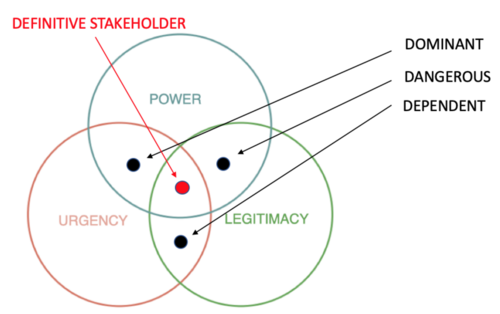Rambøll2020
Collection of tools
Risk Management In Project Portfolios Cite error: Closing </ref> missing for <ref> tag ]]
Secondly we want to evaluate a stakeholder match by Stakeholder Compatibility. This is done by categorizing the relationships into the “Four Stakeholder Configurations”. It is also this step where the “Stakeholder Matrix” comes in play, which is an interest/power matrix. Lastly Stakeholder Management involves creating stakeholder engagement. In this step we utilize “Stakeholder Engagement approaches” and “Stakeholder integration methods”.
Fault Tree Analysis This tool is one of the methods that is used the most in system reliability, maintainability and security analysis. It is used to determine which undesired events could happen. This method starts by having a conclusion from where specific causes are determined by constructing the fault tree. When using this method, the purpose is to identify potential causes of a failure before it happens. When the analysis is performed it can be determined what happens based on the different factors through the tree. Cite error: Closing </ref> missing for <ref> tag ]]
The figure above is known as the business canvas model, in that it has 9 building blocks, the are as follow, KP is Keypartners , KA is Key activities, KR is key resources, VP is value proposition, CR is customer relationship, CH is channels, CS is customer segment, CS is cost structure and RS is revenue streams.
The use of this tool, is to divide the business model into smaller parts/blocks which provide a better overview of the whole picture, and make the process for any change tangible.
SWOT
SWOT-analysis is a tool that helps the organization to identify strengths, weakness, opportunities and threats. The internal organization concerns the strengths and weakness of the organization and externally the environmental opportunities and threats are analyzed and defined.
The manager can based on the SWOT-analysis select the corporate, business, and functional strategies to put the organization in a better position and achieve the desired goals.
The first step for the manager is to identify the strengths and weaknesses from the current situation of the organization. Afterwards it is desired to take benefit from the strengths and correct the weakness that may affect the organization in the future.
The second step is defining the external factors and taking advantage of any opportunity that might occur and work on the threats.
The tool ensures the managers that they make the most of what the organization got and reduces the risk of failures by understanding and defining what the organization is lacking, which will result in a better position in that market.

Tabel The table above shows what a SWOT Analysis matrix could look like.
Four Classical Functions of Management
The use of this tool is to establish a overlook for the mangere, of where the problem of his/hers management is, and to help provide the understanding and information needed to any changes to help solve that problem. When working with this tool, there are four functions, first function is Planning, which is that the manager is choosing the right organizational goals to provide and achieve those goals, second function is Organizing, which is that the manager has the right setup for his works, and is best suited to their abilities. Third one is Leading, which the managers ability to motivate and coordinate their staff to achieve organizational goals. And the last one is Controlling, here there is looked at which system or ways the manager measure og monitor the work progress.
STAR-model
The Star Model consists of five areas that should be connected and aligned to successfully shape the decisions and behaviors of your organization: Strategy, Structure, Processes, Rewards, and People.

1. Strategy The strategy comes first in the model as it sets the direction of the organization. An organization's strategy of an organization is defined by the vision, mision and values as well as the goals.
2. Structure
3. Business, processes & lateral links 4. Rewards systems 5. Human resource management